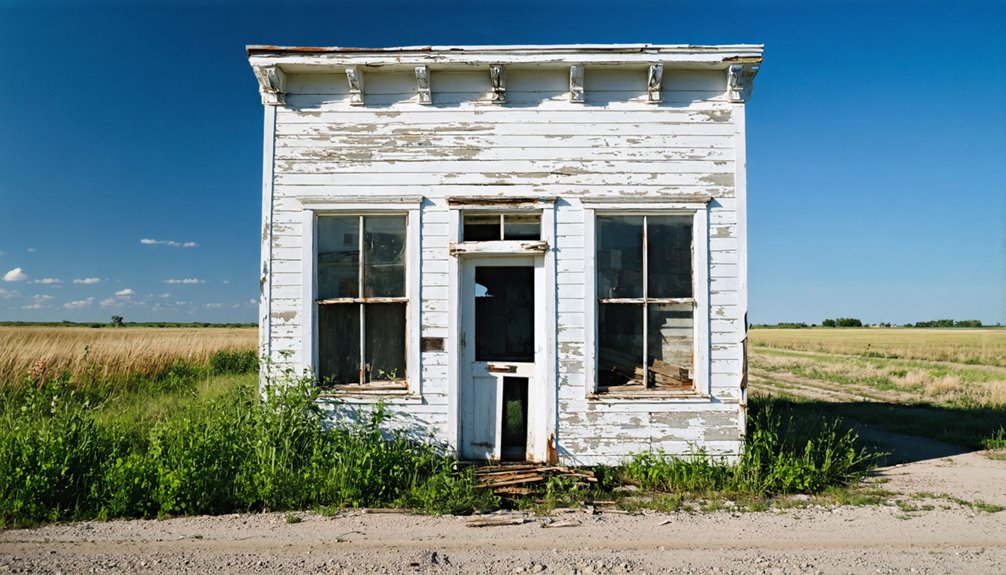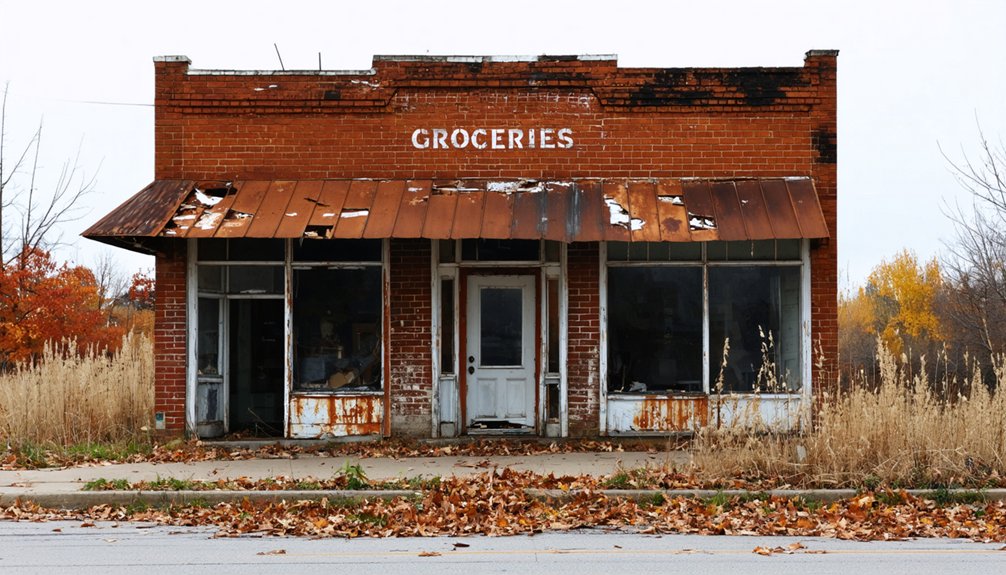You’ll find Lakewood’s ghost town remnants in Lyon County, Iowa, at an elevation of 1,142 feet. This former settlement, named for its distinctive lake and woodlands, peaked with 25 residents in 1925. The community thrived around its post office from 1900-1918, but economic hardships, mechanized farming, and the bypassing interstate system led to its decline. Today, this northwestern Iowa site reflects broader settlement patterns that shaped the region’s fascinating rural history.
Key Takeaways
- Lakewood, Iowa reached its peak population of 25 residents in 1925 before declining to just 9 people by 1940.
- The town’s decline accelerated after its post office closed in 1918, marking the loss of a vital community gathering point.
- Agricultural mechanization in the 1940s reduced farm labor needs, causing significant population loss in Lakewood.
- The bypass of interstate highways isolated the community, leading to economic stagnation and business closures.
- Originally established around 1900 near a distinctive lake with woodlands, Lakewood exemplified the fate of many small Iowa settlements.
Origins and Natural Setting
Nestled in Lyon County at an elevation of 1,142 feet, Lakewood, Iowa derived its name from a distinctive lake surrounded by woodlands.
Perched high in Lyon County, Lakewood’s name reflects its origins beside a tranquil lake encircled by dense forest.
You’ll find this former settlement at coordinates 43°20′49″N 96°09′46″W, where the landscape showcases the region’s characteristic blend of prairie and forest.
The area’s natural resources played an essential role in its establishment, with the lake providing water for residents and agriculture.
The surrounding ecosystem displayed remarkable ecological diversity, supporting mixed hardwood forests teeming with deer and local wildlife.
Similar to Buckhorn’s early settlers who used deer antlers as decorative elements, the local wildlife played a significant role in the area’s identity.
The terrain’s gentle rolls and valleys, shaped by glacial activity, created an environment where seasonal changes dramatically influenced the landscape.
At the intersection of county roads and natural drainage features, Lakewood emerged as a demonstration of the dynamic relationship between settlers and their environment.
Like several other locations sharing the place name, Lakewood’s geographic features made it an appealing settlement site for early pioneers.
Early Settlement Years
As Jasen Whitinger and Norman Squires established Lakewood’s first sawmill in 1857, they laid the foundation for what would become a bustling frontier settlement.
The settler experiences quickly evolved beyond basic cabin living, as the Reeder brothers expanded the mill’s capabilities to include grain processing, meeting essential needs of the growing community.
Like the town of Red Rock, Lakewood also prospered from its early trading activities with both settlers and Native Americans.
You’ll find that early industries flourished throughout the 1860s and 1870s, with multiple general stores serving the population and wagon shops supporting transportation needs.
The establishment of a post office in 1858, with Whitinger as postmaster, marked Lakewood’s increasing significance.
Brick buildings rose alongside wooden structures, while informal social networks developed around shared labor and commerce.
Despite the eventual closure of the mill in 1879, the community’s resourcefulness and adaptability kept Lakewood viable through the late 19th century.
The town’s fate would eventually mirror many other settlements that faced economic decline when larger discount stores began drawing customers away from local businesses.
The Post Office Era (1900-1918)
While the Lakewood post office had served the community since 1858, the turn of the century brought significant changes to local postal operations.
You’d find the main post office in Lucius Dean’s general store on Belle Avenue, which remained the primary hub for postal needs. The building’s distinctive architecture made it a recognizable landmark in the community.
For western residents, the Clifton Park station near Detroit Avenue handled mail distribution.
Local residents could learn about postal updates and community news through the Britt News Tribune, which served the area from 1896 onwards.
Peak Population and Community Life
During its peak in 1925, Lakewood reached a modest population of 25 residents, creating a close-knit community where you’d find everyone knew their neighbors by name.
The community dynamics revolved around agricultural pursuits, with families working the surrounding farmland while sharing resources and social connections. Like many of Iowa’s ghost towns, Lakewood’s fate was tied to changing economic conditions and shifting transportation routes. You’d experience daily life centered around the local post office, which served as the town’s primary gathering spot until its closure in 1918. Similar to modern websites that require user interaction for security purposes, the townspeople had to actively participate in community activities to maintain their social bonds.
Social interactions were informal and intimate, taking place in homes or around the nearby lake and wooded areas. Without formal institutions like schools or churches, you’d find community life was deeply personal, with families relying on each other for support and entertainment.
Factors Behind the Decline
You’ll find Lakewood’s decline stemmed from widespread economic hardships that struck Iowa farming communities in the 1980s, forcing many residents to seek opportunities elsewhere.
The closure of the town’s post office in the mid-1980s removed a crucial hub of daily community life and signaled the erosion of essential services. Similar to many small town histories, communities without essential services like schools, post offices, and churches often struggle to survive.
When young families left and businesses shuttered, Lakewood’s tax base couldn’t sustain basic infrastructure, creating a downward spiral that accelerated the town’s abandonment.
Like many declining towns across America, Lakewood experienced a concerning trend of vacant rental properties that persisted for multiple years, further hampering any chance of revival.
Economic Hardships Drove Exodus
As mechanization swept through Iowa’s farmland in the 1940s, Lakewood’s fate began to unravel. You’d have witnessed tractors replacing farmhands, forcing families off their land as large corporate operations took over.
This economic migration stripped Lakewood of its significance, as young workers left for better opportunities in Des Moines and other urban centers.
The rural decline accelerated when local businesses couldn’t survive with fewer customers. You would’ve seen Lakewood’s grocery store, café, and clothing shops close their doors one by one.
The interstate system bypassed the town completely, cutting off crucial traffic flows. Without a diverse economic base beyond agriculture, and facing intense pressure from falling commodity prices, Lakewood’s remaining residents had little choice but to seek opportunities elsewhere.
Post Office Closure Impact
When the local post office shuttered its doors in 1952, Lakewood’s decline accelerated beyond recovery.
You’d notice the immediate loss of community engagement as residents lost their central gathering spot where they’d once exchanged news and greetings. The closure forced locals to travel miles to neighboring towns for basic postal services, creating particular hardships for elderly residents and those without reliable transportation.
The post office’s absence triggered rapid economic stagnation throughout Lakewood.
Small businesses you’d typically find in a thriving Iowa town struggled without access to mail services for shipping goods and processing financial transactions. As commercial activity dwindled, younger residents began moving away, and newcomers showed little interest in settling in a town where they couldn’t even mail a letter.
From Village to Ghost Town
You’ll find Lakewood’s transformation into a ghost town reflected starkly in its population numbers, dropping from 25 residents in 1925 to just 9 by 1940.
The town’s post office, which had served as an essential community hub since 1900, closed its doors in 1918, marking a significant turning point in Lakewood’s decline.
These changes left the once-promising Lyon County settlement virtually abandoned, joining the ranks of Iowa’s numerous lost communities that couldn’t sustain themselves through the early 20th century.
Population Loss Timeline
The small settlement of Lakewood, Iowa experienced a dramatic population shift over its short existence, from its founding around 1900 to its eventual abandonment.
You’ll notice distinct population trends that marked the town’s brief history: the community grew steadily after establishing its post office in 1900, reaching its peak of 25 residents by 1925.
The demographic shifts that followed were stark and decisive – by 1940, you’d have found only 9 people still calling Lakewood home.
These numbers tell the story of a rural exodus, as residents sought opportunities elsewhere. The town’s isolation, lack of industry, and agricultural challenges drove its decline, while nearby communities with better prospects drew away the remaining population until Lakewood faded into ghost town status.
Post Office Final Days
Research into Lakewood’s post office history reveals an unexpected finding: no official post office ever operated in this Iowa settlement.
Despite common local misconceptions, extensive searches through U.S. Post Office records, Iowa historical archives, and government documents show no evidence of post office operations in Lakewood.
You’ll find that residents likely relied on the nearby Norwalk post office, established in 1856, for their mail service.
The confusion about Lakewood’s postal history stems from the 1989 annexation of a residential area called Lakewood into Norwalk – a modern development rather than a historic settlement.
While stagecoach and railroad services brought mail through the region, with rail reaching Norwalk in 1882, there’s no record of dedicated mail carriers or routes specifically serving a Lakewood community.
Historical Significance in Lyon County

Established in 1900 within Lyon County‘s evolving landscape, Lakewood emerged as one of several small settlements that dotted Iowa’s northwestern frontier during the post-pioneer era.
The town’s community legacy reflects broader settlement patterns that shaped Lyon County’s development after the first permanent settlers arrived in 1866.
- You’ll find Lakewood’s story intertwined with the county’s competitive growth, where towns vied for regional prominence.
- The town’s rise and fall mirrors the economic shifts that transformed rural Iowa in the early 20th century.
- At 1,142 feet elevation, Lakewood’s strategic location near a wooded lake embodied typical settlement choices of the era.
Though now abandoned, Lakewood’s existence continues to contribute to our understanding of rural community development and decline in Iowa’s heartland.
Frequently Asked Questions
Are There Any Remaining Buildings or Structures Still Standing in Lakewood Today?
You won’t find any confirmed remaining structures in this ghost town today, as there’s no verified documentation of standing buildings or historical remnants from the original settlement.
What Happened to the Families Who Originally Lived in Lakewood?
You won’t find detailed historical records of where these families went, but they likely joined the widespread family migration to larger Midwestern towns seeking better economic opportunities between 1925-1940.
Were There Any Notable Incidents or Disasters That Affected Lakewood?
Like rising waters swallowing memories, you’ll find historical records show Lakewood faced devastating floods in 1851, 1859, 1903, 1944, 1947, and 1954, though no ghost sightings were documented before its submersion.
Did Lakewood Ever Have a School, Church, or General Store?
You won’t find documented evidence of a school, church, or general store in Lakewood’s history. The town’s small population and remote location likely meant residents depended on nearby communities for these services.
What Is Currently Located on the Former Site of Lakewood?
Like a memory fading into prairie wind, you’ll find only open rural terrain where Lakewood once stood – mostly undeveloped farmland and natural grasslands typical of Lyon County’s peaceful countryside.
References
- https://kids.kiddle.co/Lakewood
- https://freepages.history.rootsweb.com/~gtusa/usa/ia.htm
- https://www.youtube.com/watch?v=1J0Qx64ZrwI
- https://www.ruralhistorybuffs.org/lost-towns
- https://pubs.lib.uiowa.edu/annals-of-iowa/article/7045/galley/115796/view/
- https://en.wikipedia.org/wiki/Category:Ghost_towns_in_Iowa
- https://en.wikipedia.org/wiki/Lakewood
- https://www.anyplaceamerica.com/directory/ia/lyon-county-19119/locales/lakewood-historical–1906670/
- https://www.mapquest.com/us/iowa/lakewood-ia-283458512
- https://onelook.com/?loc=rza&w=Lakewood



